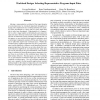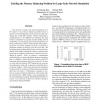421 search results - page 79 / 85 » A divide-and-merge methodology for clustering |
IEEEPACT
2002
IEEE
14 years 10 days ago
2002
IEEE
Having a representative workload of the target domain of a microprocessor is extremely important throughout its design. The composition of a workload involves two issues: (i) whic...
ICDT
2001
ACM
13 years 12 months ago
2001
ACM
This paper presents a general methodology for the efficient parallelization of existing data cube construction algorithms. We describe two different partitioning strategies, one f...
AFRIGRAPH
2010
ACM
13 years 11 months ago
2010
ACM
Aligning structures, often referred to as docking or registration, is frequently required in fields such as computer science, robotics and structural biology. The task of alignin...
HIS
2007
13 years 8 months ago
2007
—Machine learning is inherently a multiobjective task. Traditionally, however, either only one of the objectives is adopted as the cost function or multiple objectives are aggreg...
MASCOTS
2008
13 years 8 months ago
2008
A key obstacle to large-scale network simulation over PC clusters is the memory balancing problem where a memory-overloaded machine can slow down an entire simulation due to disk ...


